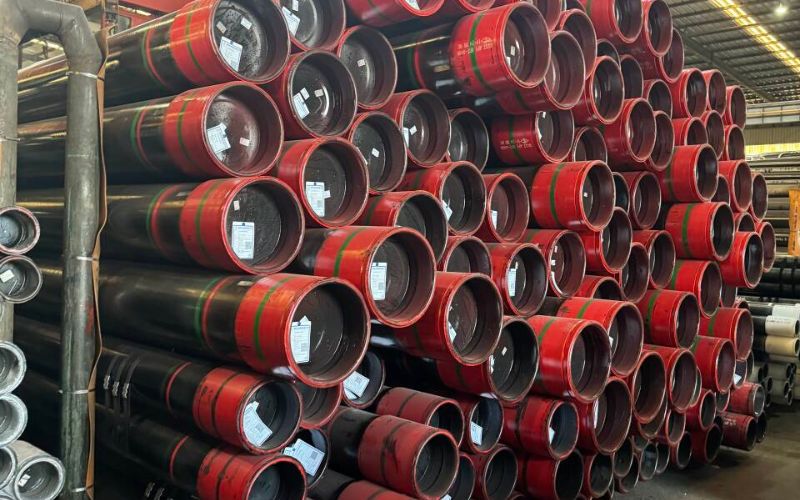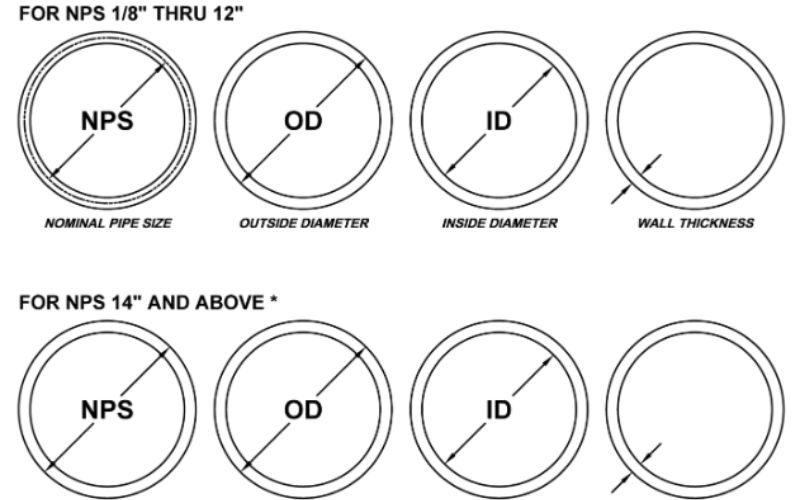Steel pipes play an important role in various industrial, residential, and civil works, from infrastructure projects to plumbing systems. They function as a medium for conveyance systems and are useful for transporting minerals and petroleum products. Steel pipes are one of the most versatile construction materials available today. The differences between steel pipe types are important to consider when choosing an appropriate pipe for a given project. This article covers the production, the possible uses, and the characteristics of cast iron, seamless, and steel pipes. Our primary aim is to enable readers to make more informed choices by shedding light on the distinct uses and features of each type of pipe. Shaping metal into pipes is an environment extremely close to magic that most people never become aware of. This guide is useful for both professionals and amateurs who want to know more about steel pipes.
Introduction to Steel Pipes
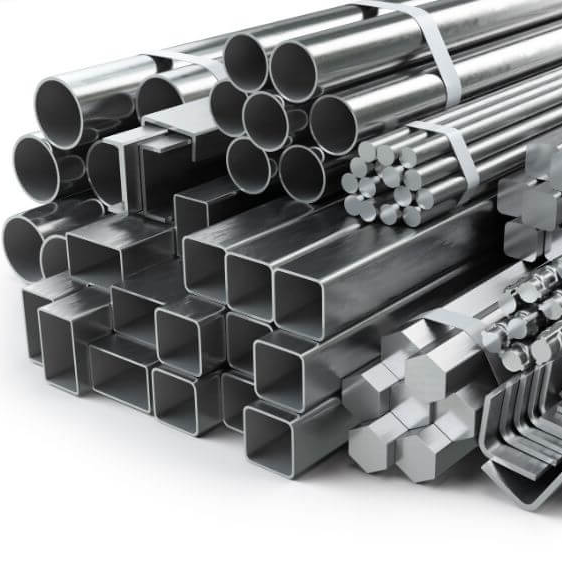
Steel pipes are cylindrical tubes widely used in the transportation of liquids, gases, and other materials in industries such as construction, energy, and manufacturing. Being strong, durable, and corrosion-resistant, they are the very pipeline between the core of infrastructure and industrial assignments. The steel pipes are primarily manufactured in three forms: seamless, welded, and cast iron, which are suitable for different applications, depending on considerations such as pressure, temperature tolerance, and environmental conditions. It is this versatility that makes steel pipes exceptional in engineering and industrial uses.
Definition and Importance of Steel Pipes
Steel pipes are cylinders of or conduits made out of steel for the conveyance of fluids and gases or for structural applications. Considered foundational elements for industrial and infrastructure development, steel pipes boast excellent strength properties and good resistance to mechanical stress, including high-pressure and high-temperature conditions. Their corrosion-resistant properties provide security from environmental hazards, which is why steel pipes retain their integrity for longer on-site, making them suitable options for a wide variety of uses within the construction, energy, automotive, and manufacturing industries.
The three main varieties of steel pipes—Seamless, Welded, and Cast Iron—each serve a different need. Seamless pipes, without any physical joint, are used in high-pressure and critical situations, such as the conveyance of oil and gas. Welded steel pipes are manufactured from rolled steel with a welded seam and have a lower price and are good enough for low-pressure applications. Cast iron pipes are rarely used today but serve well in underground water and sewage applications. This flexibility ensures that steel pipes remain an integral part of modern engineering and industrial systems.
Overview of the Pipe Industry
In the era of technological advancement of materials, manufacturing processes, and application-based solutions, the pipe industry continues to evolve. The steel pipe industry maintains its strength and stature due to the superior strength, durability, and versatility of its products. Demand for seamless steel pipes is driven by their high reliability in areas where high pressure is standard, such as energy transmission and industrial applications. However, sustainability has been a major driver for alternative production pathways with recycled materials and resource-efficient processes deemed the best options. Likewise, the further application of advanced technologies, such as innovative coatings for enhanced corrosion resistance, along with inspection technologies for quality assurance, has helped steel pipes adapt to the changing needs of infrastructure. The substantial growth generated by emerging markets in the Asia-Pacific region is accompanied by a surge in construction, energy, and water management projects worldwide.
Types of Steel Pipes and Their Applications
Steel pipes are classified into several types based on their manufacturing process and intended use. Major types include:
Seamless Steel Pipes
Seamless pipes are manufactured without welding or seams, where a solid billet is used for extrusion, hence the name. Such pipes have the advantage of enduring high-pressure applications, and therefore they are extensively used in oil and gas industries, boiler systems, automobile manufacturing, power plants, etc., as they withstand extreme temperature and pressures.
Welded Steel Pipes
Welded pipes are formed by rolling strips or sheets of steel into a tubular shape and then welding the edges. Less costly than seamless ones, welded steel pipes are primarily considered for medium- to low-pressure applications, such as water pipelines, structural works, and HVAC systems.
Galvanized Pipes
Galvanized pipes, coated with zinc for enhanced corrosion resistance, are widely used in water distribution, sprinkler systems for fire prevention, and outdoor construction, due to their longer lifespan in adverse weather conditions.
Stainless Steel Pipes
Being corrosion-resistant and chemically reactive, stainless steel pipes are primarily used in food processing, pharmaceutical, and chemical industries. They are also extensively used in architectural purposes due to their aesthetic appearance.
Alloy Steel Pipes
Alloy steel pipes are those enhanced with the addition of extra elements, such as chromium, molybdenum, or manganese, to provide them with additional strength and improved resistance to heat and corrosion. Such pipes are heavily utilized in the power generation, aerospace, and petrochemical industries.
Seamless Steel Pipes
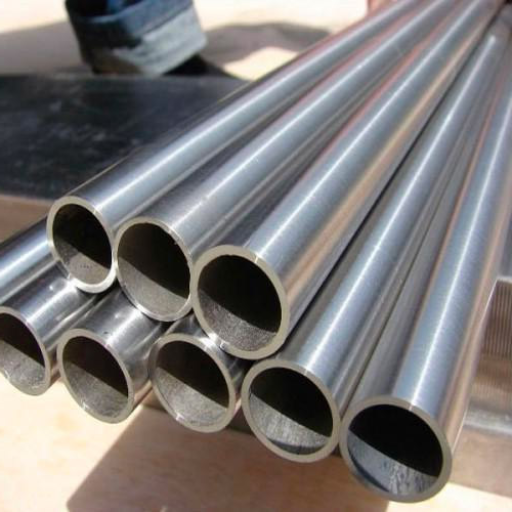
These types of pipes are manufactured in a manner that ensures there is no welded joint, which results in a more or less homogeneous structure along the length of the pipe. The hot forming and cold drawing processes impart these pipes with greater strength, precise dimensions, and enhanced pressure resistance. Due to their ability to withstand extreme conditions, they are preferred wherever such processes are involved; for instance, the transportation of oil and gas, boiler construction, heat exchanger fittings, and high-pressure systems. These pipes receive special consideration in almost all industries due to the manufacturing process’s ability to minimize structural weaknesses. Hence, they are required in industries where the utmost integrity and durability of the system are needed.
Manufacturing Process of Seamless Pipes
- Selection of billets: The first step in making seamless pipes is selecting good-quality, solid, cylindrical steel billets.
- Heating process: These billets are heated to a specific temperature to make the metal malleable.
- Piercing: The billets are then pierced with a rotary piercing mill or mandrel into a hollow shell.
- Elongation: Next, the hollow shell is elongated with use of a pilger mill or mandrel mill to attain the needed thickness and diameter.
- Refinement: This process may involve multiple rolling and reheating steps to refine the pipe’s dimensions and mechanical properties.
- Final treatment: The pipe is then allowed to cool, straightened, and thoroughly tested to meet quality requirements and standards.
Key Features and Benefits
High Strength and Durability
Seamless steel pipes possess a higher strength property as they are manufactured without welded joints, which can be weaker points in a structure. Being stable even under very high pressure and temperature conditions, this structure can therefore guarantee the smooth functioning of any heavy-duty operation.
Enhanced Corrosion Resistance
Seamless steel pipes can be either coated or made from alloys that resist corrosion; hence, their applications may extend to highly corrosive environments, such as those found in the chemical processing, marine industries, and oil and gas transport sectors.
Superior Dimensional Accuracy
The domestic manufacturing process of seamless pipes enables tighter dimensional tolerances and more uniform wall thicknesses compared to welded pipes. Such precision is essential when exact specifications are required, for example, in hydraulic and pneumatic systems.
Broad Base Distribution
Stronger with superior mechanical properties, seamless steel pipes are found wherever the energy, construction, automotive, and aerospace industries are active. The high pressure and stress they can endure qualify them as pipes for gases, liquids, and other vital fluids.
Low Maintenance and Cost-Effectiveness
Because these pipes possess the strongest mechanical characteristics and are most durable, repairs and replacements are rarely required, resulting in lower maintenance costs in the long run. And since they are longer-serving types, their service life also becomes a factor contributing to higher cost efficiency.
Common Applications of Seamless Steel Pipes
- Oil and Gas Sector: These pipes find their most extensive application in the extraction, transportation, and refining of oil and gas; this is due to their ability to withstand pressures well above normal and posed harsh environmental conditions.
- Power Generation: These pipes are crucial, as large plants generate valuable steam and water under very high temperatures and pressures.
- Automotive Sector: Seamless piping finds application in the automotive sector by manufacturing drive shafts, exhaust systems, and hydraulic systems that require both dimensional accuracy and strength.
- Construction and Structural: Due to their high strength and durability, seamless pipes excel in structural steel construction and infrastructure projects.
- Chemical and Petrochemical Industry: Resistant to corrosive processes, seamless steel pipes are used for transporting chemicals, acids, and other hazardous materials.
Welded Steel Pipes
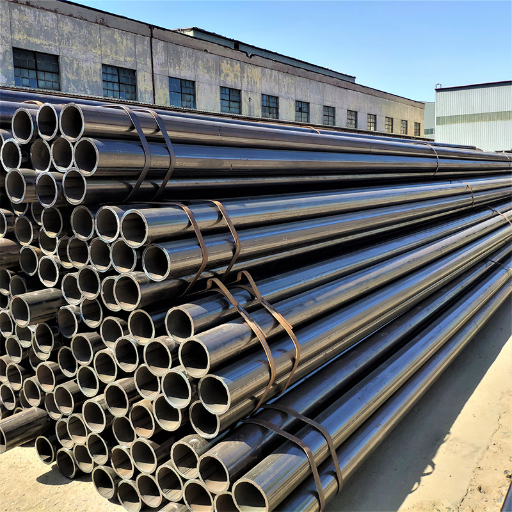
The formation of welded steel pipes involves rolling steel plates into cylindrical shapes and welding the edges to create continuous seams. These pipes find applications in the water distribution, construction, and automotive industries, as they are cost-effective and available in larger diameters. Mostly, welded pipes have a lower pressure capacity compared to their seamless counterparts; however, welding technologies have evolved, enabling welded pipes to be made more durable for improved performance in applications.
Welding Techniques and Manufacturing Process
Two primary methods are used for making welded steel pipes: ERW and LSAW. The ERW process involves heating the edges of the steel strip by electrical resistance and applying pressure to forge the seam, creating a high-quality weld without the need for fillers. This process is mainly used for thinner-walled pipes, where applications may include water pipeline and scaffolding.
In any other method, LSAW shall mean that submerged arc welding is underway: steel plates are rolled into a cylinder form, and the arc weld is done under a blanket of flux. This production lends itself better for large diameter pipes with excellent structural integrity: primarily for use in the energy sector and in building extensive infrastructure like bridges and offshore platforms.
In either case, stringent pre- and post-weld treatment are carried out to strengthen the pipe and make it resistant to corrosion and pressure. Pre-weld processes include edge preparation and cleaning to achieve proper alignment, while post-weld heat treatment (PWHT) is usually applied to reduce residual stress and enhance metallurgical properties. The weld quality undergoes inspection techniques such as ultrasonic testing or X-rays to ensure safety standards and meet the performance criteria demanded by the industry.
Advantages of Welded Steel Pipes
✓ Less Expensive
Compared to seamless pipes, welded steel pipes tend to be less expensive to manufacture due to the simpler procedures and readily available steel plates or coils.
✓ More Customizable
These pipes can be fabricated in a large variety of sizes and lengths and thus can meet specific requirements at a small cost of materials.
✓ High Strength and Durability
New-age welding technologies and post weld treatments confer very good mechanical properties to welded steel pipes, capable to withstanding high pressures and adverse environmental conditions.
✓ Ease of Production
Welding enables rapid production cycles with increased efficiency, making welded steel pipes readily available for various sectors, including oil and gas, construction, and transportation.
✓ Best Surface Finish
Welded steel pipes feature smooth internal and external surfaces, resulting in reduced resistance to fluid flow and improved performance in applications where precision and cleanliness are crucial.
Applications in Various Industries
- Oil and Gas: Due to Holes-Durability and Pressure-Resisting Properties, these pipes are used in crude oil, natural gas and petroleum product transportation.
- Construction Industry: In structural applications such as scaffolding or pilings and building frameworks, welded steel pipes provide requisite strength and support for major construction activities.
- Water and Sewage Systems: These pipes are used in water supply networks and sewerage systems due to their corrosion resistance, ensuring the safe transportation of fluids.
- Automotive Industry: Welded steel pipes are for vehicle manufacturing into exhaust systems, frames, and other components where precision and structural integrity are required.
- Power Generation: Owing to their thermal resistance and efficiency, they serve crucial functions in power plants as conduits in boiler, cooling, and heat exchange systems.
Cast Iron Pipes
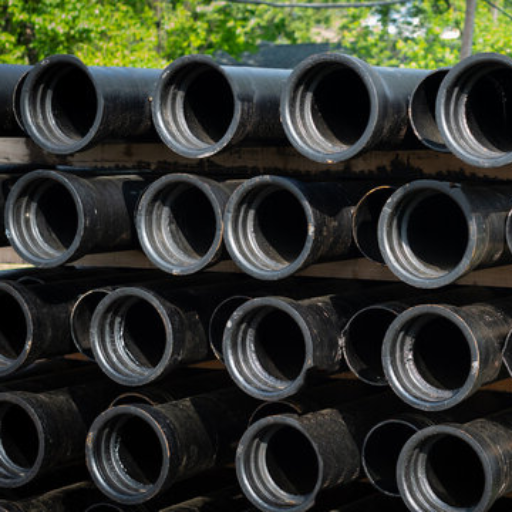
Primarily employed in various plumbing, drainage, and sewerage systems, cast-iron pipes are chosen for their exceptional durability and sound-dampening properties. They resist abrasion and wear, making them suitable for transporting abrasive materials. Cast-iron pipes, being able to withstand high-temperature exposure and resist fire, are safer choices in pertinent installations where the working life is a significant consideration. However, cast iron pipes are heavier and more brittle than steel pipes, limiting their use in some modern applications.
Characteristics and Manufacturing Process
Cast iron pipes are known for their durability, corrosion-resistant features, and ability to withstand high pressure and extreme temperatures. They are primarily used in sewage, drainage, and water supply systems for their longevity and reliability. Due to the dense nature of the material, cast iron pipes offer excellent noise-dampening properties, providing effective options for reducing sound transmission through building design.
The manufacturing process for cast iron pipes involves melting iron and then casting it into shapes in molds, utilizing one of the three standard casting methods: centrifugal, sand, or continuous casting. Centrifugal casting is the most common method, where vividly rotating molds create pipes with consistent wall thickness and strength properties. Sand casting is essentially an older method that uses less precise sand molds. In continuous casting, longer pipes are produced through a more efficient process. After casting, the pipes are annealed to release internal stresses and coated or lined for corrosion resistance. These production advances ensure consistent quality and fulfillment of modern engineering standards.
Benefits of Using Cast Iron Pipes
🔧 Durability and Longevity
Cast iron pipes are known to be subjected to extremely high internal and external pressures and are, therefore, highly durable for extended periods of use.
🛡️ Corrosion Resistance
With appropriate coatings or linings, cast iron pipes resist corrosion quite well, ensuring dependable performance under a variety of environmental conditions.
🔇 Noise Dampening
Cast iron has sound-insulating qualities and is effective at reducing noise due to water flow or drainage; for these reasons, cast iron pipes are suitable for both residential and commercial applications.
🔥 Fire Resistance
Being non-combustible in nature, cast iron pipes add an element of safety to building interiors by being an option for firefighters’ safety.
♻️ Sustainability
Since the material is recyclable, decommissioned cast iron pipes can be recycled using a general sustainable construction method, which in turn reduces pollution.
Typical Uses in Construction and Plumbing
Cast iron pipes are a standard application in Construction and plumbing due to their durability, strength, and noise-dampening qualities. Primarily, they are used for sanitary drainage systems to transport wastewater and sewage in homes, commercial establishments, and industrial buildings. Their fire-resistant properties make them especially suitable for use in multi-story constructions, such as apartment buildings and office complexes, where fire safety is paramount. Furthermore, cast iron pipes remain a preferred material for stormwater drainage and vent piping applications, thereby promoting efficient water flow management and minimizing environmental noise.
Choosing the Right Type of Steel Pipe for Your Project
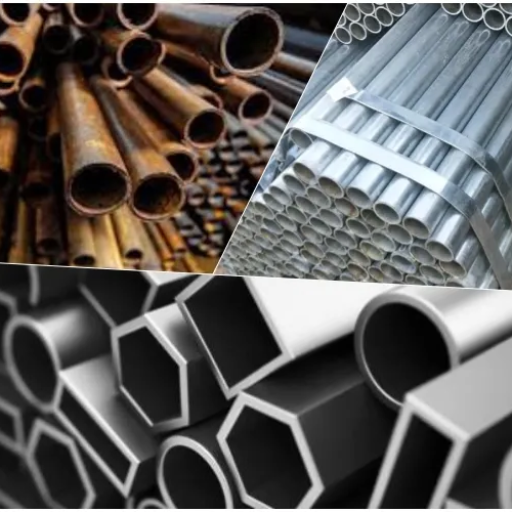
An array of factors must be considered when selecting the type of steel pipe that is right for your project, ensuring maximum performance while balancing safety and economic considerations. These considerations include the following aspects:
Material Composition
This concerns applying whether carbon steel, stainless steel, or alloy steel is appropriate for the application and the actual environment in which it will be used. For example, stainless steel can be used where corrosion resistance is paramount, whereas carbon steel may be chosen when cost is a major factor and the environment is not corrosive.
Pressure and Temperature Ratings
Here, the concern is given to the working pressure and temperature that the pipe should withstand. High-pressure or high-temperature systems often require special steel grades or reinforced pipe designs.
Application Requirements
Identify the particular use case—Plumbing, gas transportation, or structural—and make sure the pipe used suits the applicable industry standard specification, such as ASTM or ASME.
Pipe Dimensions
Depending on the flow capacity, structural integrity, and specified constraints in your project blueprint, consider diameter, wall thickness, and overall length.
Corrosion Resistance
If the pipes are to operate with corrosive substances or in corrosive environments, materials that are inherently resistant or treated by galvanization or coating should be prioritized.
Budget and Installation Costs
This should present a balance between quality of material and budget constraints. Factors such as installation ease, pipe maintenance needs, and, ultimately, pipe lifespan should also be considered.
Factors to Consider When Selecting Steel Pipes
- Material Composition: Check whether carbon steel, stainless steel, or alloy steel is most suitable with regard to chemical and mechanical requirement differences of the application. Different types vary in strength, corrosion resistance, and durability.
- Pressure and Temperature Ratings: Pipe steel should resist pressures and temperature ratings that are operationally applicable; beyond these limits, the structural integrity of the pipe may be compromised.
- Resistance to Corrosion: Consider the operational environment in which the pipe will be exposed, and determine the level of resistance required against corrosion, such as moisture, chemicals, or extreme conditions.
- Dimensions and Wall Thickness of Pipe: Observe the diameter and thickness required to tie down to system design and loading specifications, and ensure compliance with the applicable industry standards.
- Standards Compliance: The steel pipe shall be tested to conform to the pertinent codes and standards such as ASTM, ASME, or API to ensure safety, reliability, and regulatory compliance in the specific means of application.
Comparison of Seamless, Welded, and Cast Iron
Seamless pipes, welded pipes, and cast iron differ in terms of manufacturing process, strength, durability, cost, and suitability for various applications.
Pipe Coating and Protection Options
Pipe coating methods offer great scope to enhance the durability and efficiency of pipes used in different applications. Priorities for protection were corrosion of the steel, flow efficiency, and overall increase of the life of the piping set. The protection options include:
🎨 Epoxy Coatings
These extremely common coatings are suitable for both internal and external applications, providing good resistance to corrosion and abrasion. They are preferred for high-pressure applications or in an environment with aggressive chemicals.
⚡ Fusion Bonded Epoxy Coating (FBE)
A thermoset coating considered more for the external application on pipelines. FBE coatings excel as moisture-resistant coatings, ultimately reducing long-term maintenance costs.
🔧 Galvanizing
A coating of zinc is applied for strong corrosion protection, primarily for pipes exposed to outdoor environments or conditions prone to moisture.
🧪 Polymer Coatings
The outer coating layer is usually greased with materials such as polyethylene or polypropylene; this treatment elongates insulation, chemical resistance, and protection at extreme temperature.
Reference Sources
-
Welded vs. seamless steel pipe – A detailed comparison of welded and seamless steel pipes, including their manufacturing processes and applications.
-
Carbon Steel and Stainless Steel Pipes – An overview of welded and seamless pipes, focusing on their material types and uses.
-
Cast iron pipe vs Carbon steel pipe – A comparison of cast iron and carbon steel pipes, including insights into seamless and welded steel pipes.
-
Steel Pipes: Choosing Between Seamless and Welded – A guide to understanding the differences between seamless and welded pipes, including their advantages and limitations.



